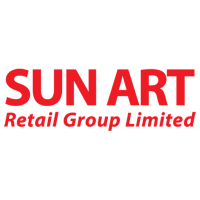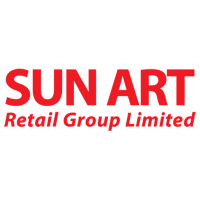
Sun Art Retail Group Ltd
HKEX:6808


| US |

|
Johnson & Johnson
NYSE:JNJ
|
Pharmaceuticals
|
| US |

|
Berkshire Hathaway Inc
NYSE:BRK.A
|
Financial Services
|
| US |

|
Bank of America Corp
NYSE:BAC
|
Banking
|
| US |

|
Mastercard Inc
NYSE:MA
|
Technology
|
| US |

|
UnitedHealth Group Inc
NYSE:UNH
|
Health Care
|
| US |

|
Exxon Mobil Corp
NYSE:XOM
|
Energy
|
| US |

|
Pfizer Inc
NYSE:PFE
|
Pharmaceuticals
|
| US |

|
Palantir Technologies Inc
NYSE:PLTR
|
Technology
|
| US |

|
Nike Inc
NYSE:NKE
|
Textiles, Apparel & Luxury Goods
|
| US |

|
Visa Inc
NYSE:V
|
Technology
|
| CN |

|
Alibaba Group Holding Ltd
NYSE:BABA
|
Retail
|
| US |

|
3M Co
NYSE:MMM
|
Industrial Conglomerates
|
| US |

|
JPMorgan Chase & Co
NYSE:JPM
|
Banking
|
| US |

|
Coca-Cola Co
NYSE:KO
|
Beverages
|
| US |

|
Walmart Inc
NYSE:WMT
|
Retail
|
| US |

|
Verizon Communications Inc
NYSE:VZ
|
Telecommunication
|
Utilize notes to systematically review your investment decisions. By reflecting on past outcomes, you can discern effective strategies and identify those that underperformed. This continuous feedback loop enables you to adapt and refine your approach, optimizing for future success.
Each note serves as a learning point, offering insights into your decision-making processes. Over time, you'll accumulate a personalized database of knowledge, enhancing your ability to make informed decisions quickly and effectively.
With a comprehensive record of your investment history at your fingertips, you can compare current opportunities against past experiences. This not only bolsters your confidence but also ensures that each decision is grounded in a well-documented rationale.
Do you really want to delete this note?
This action cannot be undone.

| 52 Week Range |
0.96
2.71
|
| Price Target |
|
We'll email you a reminder when the closing price reaches HKD.
Choose the stock you wish to monitor with a price alert.

|
Johnson & Johnson
NYSE:JNJ
|
US |

|
Berkshire Hathaway Inc
NYSE:BRK.A
|
US |

|
Bank of America Corp
NYSE:BAC
|
US |

|
Mastercard Inc
NYSE:MA
|
US |

|
UnitedHealth Group Inc
NYSE:UNH
|
US |

|
Exxon Mobil Corp
NYSE:XOM
|
US |

|
Pfizer Inc
NYSE:PFE
|
US |

|
Palantir Technologies Inc
NYSE:PLTR
|
US |

|
Nike Inc
NYSE:NKE
|
US |

|
Visa Inc
NYSE:V
|
US |

|
Alibaba Group Holding Ltd
NYSE:BABA
|
CN |

|
3M Co
NYSE:MMM
|
US |

|
JPMorgan Chase & Co
NYSE:JPM
|
US |

|
Coca-Cola Co
NYSE:KO
|
US |

|
Walmart Inc
NYSE:WMT
|
US |

|
Verizon Communications Inc
NYSE:VZ
|
US |
This alert will be permanently deleted.
 Sun Art Retail Group Ltd
Sun Art Retail Group Ltd
Sun Art Retail Group Ltd
In the expansive tapestry of China's retail landscape, Sun Art Retail Group Ltd. stands out as a prominent player commanding substantial influence. Born from a strategic partnership between RT-Mart and Auchan, Sun Art has become synonymous with hypermarkets that pepper China's urban and semi-urban hubs. Its business model thrives on offering an array of everyday necessities—from fresh produce to electronics—under one roof, appealing particularly to consumers seeking efficiency and variety in their shopping experience. Operating a vast network of hypermarkets, Sun Art has meticulously positioned itself to serve the growing consumer base of the world's most populous nation, capitalizing on the increasing demand for convenience and comprehensive product selection.
Sun Art's revenue stream flows primarily from its hypermarket operations, where the strategy hinges on high foot traffic and volume sales. The company employs competitive pricing, leveraging its scale to negotiate favorable terms with suppliers and thereby passing on value to customers. Beyond physical retail, Sun Art has astutely embraced the digital retail revolution by integrating technology into its operations, amplifying its reach through e-commerce channels and partnerships with tech giants like Alibaba. This dual-channel approach not only enhances customer convenience but also provides a robust platform for data-driven insights that help optimize inventory, tailor marketing strategies, and forecast consumer trends. Through these nimble adaptations, Sun Art maintains its competitive edge, ensuring steady growth in an ever-evolving retail market.

In the expansive tapestry of China's retail landscape, Sun Art Retail Group Ltd. stands out as a prominent player commanding substantial influence. Born from a strategic partnership between RT-Mart and Auchan, Sun Art has become synonymous with hypermarkets that pepper China's urban and semi-urban hubs. Its business model thrives on offering an array of everyday necessities—from fresh produce to electronics—under one roof, appealing particularly to consumers seeking efficiency and variety in their shopping experience. Operating a vast network of hypermarkets, Sun Art has meticulously positioned itself to serve the growing consumer base of the world's most populous nation, capitalizing on the increasing demand for convenience and comprehensive product selection.
Sun Art's revenue stream flows primarily from its hypermarket operations, where the strategy hinges on high foot traffic and volume sales. The company employs competitive pricing, leveraging its scale to negotiate favorable terms with suppliers and thereby passing on value to customers. Beyond physical retail, Sun Art has astutely embraced the digital retail revolution by integrating technology into its operations, amplifying its reach through e-commerce channels and partnerships with tech giants like Alibaba. This dual-channel approach not only enhances customer convenience but also provides a robust platform for data-driven insights that help optimize inventory, tailor marketing strategies, and forecast consumer trends. Through these nimble adaptations, Sun Art maintains its competitive edge, ensuring steady growth in an ever-evolving retail market.





























 You don't have any saved screeners yet
You don't have any saved screeners yet
